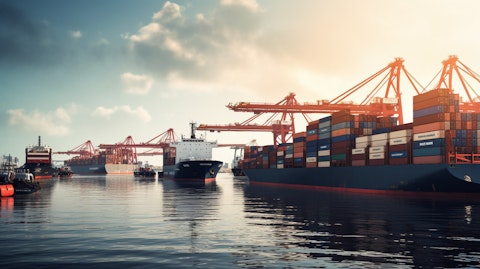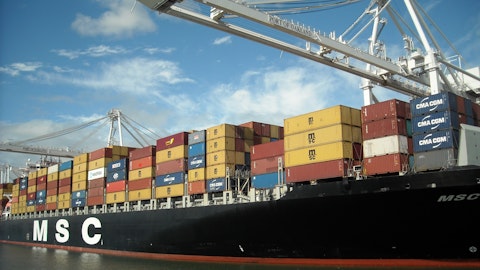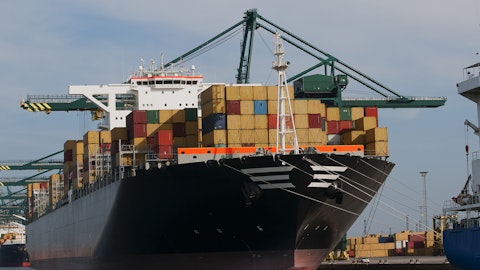Matson, Inc. (NYSE:MATX) Q3 2023 Earnings Call Transcript October 30, 2023
Matson, Inc. beats earnings expectations. Reported EPS is $3.4, expectations were $3.36.
Operator: Good day, and thank you for standing by. Welcome to the Matson’s Third Quarter 2023 Financial Results Conference Call. At this time, all participants are in a listen-only mode. After the speakers’ presentation, there will be a question answer session. [Operator Instructions] Please be advised that today’s conference is being recorded. And I would now like to hand the conference over to your speaker today, Mr. Lee Fishman, Vice President of Finance. Sir, please go ahead.
Lee Fishman : Thank you, Chris. Joining me on the call today are Matt Cox, Chairman and Chief Executive Officer; and Joel Wine, Executive Vice President and Chief Financial Officer. Slides from this presentation are available for download at our website, www.matson.com, under the Investors tab. Before we begin, I would like to remind you that during the course of this call, we will make forward-looking statements within the meaning of the federal securities laws regarding expectations, predictions, projections or future events. We believe that our expectations and assumptions are reasonable. We caution you to consider the risk factors that could cause actual results to differ materially from those in the forward-looking statements in the press release, the presentation slides and this conference call.
These risk factors are described in our press release and presentation and are more fully detailed under the caption Risk Factors on pages 14 to 24 of our Form 10-K filed on February 24, 2023, and in our subsequent filings with the SEC. Please also note that the date of this conference call is October 30, 2023, and any forward-looking statements that we make today are based on assumptions as of this date. We undertake no obligation to update these forward-looking statements. I will now turn the call over to Matt.
Matt Cox : Okay. Thanks, Lee, and thanks to those on the call. Starting on Slide 3. Matson’s Ocean Transportation and Logistics business segments continued to perform well despite a challenging business environment and relatively difficult economic conditions impacting the U.S. consumer. For the third quarter, within Ocean Transportation, our China service experienced solid freight demand despite the muted peak season in the Transpacific tradelane, but generated lower year-over-year volume and freight rates, which were the primary contributors to the year-over-year decline in our annual — in our consolidated operating income. We also saw lower year-over-year volumes in Hawaii, Alaska and Guam compared to the year ago period.
In Logistics, operating income decreased year-over-year primarily due to lower contributions from [Transpacific] brokerage. I will now go through the third quarter performance of our tradelanes, SSAT and logistics. So please turn to the next slide. Hawaii container volume for the third quarter decreased 1.9% year-over-year primarily due to lower general demand. Volume in the third quarter of 2023 was 0.8% higher than the volume achieved in the third quarter of 2019. Please turn to Slide 5. In August, Maui experienced a significant economic disruption from devastating wildfires. According to UHERO, September — September’s economic report, tourism to the islands may not fully recover in the next several years and the rebuilding of homes and businesses may take many years.
Demand for construction workers is expected to increase with the rebuilding efforts in Lahaina and other areas in Maui. In the near term, Matson expects economic growth in Hawaii to moderate as tourism and visitor arrivals slowly rebound from the effects of the Maui wildfires. Moving to our China service on Slide 6. Matson’s volume in the third quarter of 2023 was 1.3% lower year-over-year, primarily due to no CCX service in the quarter, partially offset by higher CLX+ volume. The higher CLX+ volume in the quarter compared to the prior year period was a result of higher utilization on the vessels and greater capacity of the CLX+ fleet. As you may recall, in the third quarter of last year, we began to see a path to normalization from the pandemic-driven highs as congestion throughout the supply chain eased.
During the quarter, we continued to see solid demand in the e-commerce and e-goods verticals and stable demand from the garments vertical. We achieved average freight rates in the quarter that were lower than the year ago period but well above those achieved in the third quarter of 2019. Matson continued to realize a significant rate premium over the SCFI in the third quarter of 2023. Please turn to Slide 7. Currently, in the Transpacific marketplace, we continue to see a reduction of deployed capacity in light of lower volumes as a result of lower consumer demand for retail goods. We continue to differentiate our China service from the others in the tradelane with a high degree of reliability and consistency, and 11-day ocean transit time and 24-hour availability at the unique shippers transport off-dock facility.
At 10% to 15% of the cost of air freight, our China service continues to offer a significant value proposition for airfreight customers with only 5 to 7 days of additional transit time. And for those customers looking to reduce their product carbon footprint, while saving a considerable amount of money, our customers tell us that switching from air freight to our expedited ocean freight product reduces their CO2 emissions by approximately 95%. Looking forward, absent an economic hard landing in the U.S., we expect trade dynamics in 2024 to be comparable to 2023 and as consumer-related spending activity is expected to remain stable. Furthermore, regardless of the economic backdrop, we continue to expect to earn a significant rate premium to the SCFI, reflecting our fast and reliable ocean services and unmatched destination services.
Please turn to the next slide. In Guam, Matson’s container volume in the third quarter of 2023 decreased 1.9% year-over-year. The decrease was primarily due to lower general demand. Volume in the third quarter of 2023 was 12.8% higher than the level achieved in the third quarter of 2019. In the near term, we expect continued improvement in the Guam economy with a low unemployment rate and a modest increase in tourism from low levels. Please turn to the next slide. In Alaska, Matson’s container volume for the third quarter of 2023 decreased 9.1% year-over-year. The decrease was due to lower export seafood volume from AAX lower northbound volume due to lower retail related demand and lower southbound volume primarily due to lower domestic seafood volumes.

Approximately 85% of the year-over-year volume decline as a result of lower seafood volumes in the AAX and Southbound services. Year-to-year, there can be rather meaningful changes in the summer volumes depending on the strength of the seasonal Alaskan catch. Compared to the third quarter of 2019, volume in the quarter was 12.9% higher. In the near term, we expect the Alaska economy to continue to benefit from low unemployment and increased energy-related exploration and production activity as a result of elevated oil prices. Please turn to Slide 10. Our terminal joint venture, SSAT, declined $22.1 million year-over-year to $1.3 million. The lower contribution was primarily due to lower demurrage revenue and lower lift volume. SSAT saw significantly less demurrage revenue in the quarter due to easing port congestion and lower lift volume consistent with lower year-over-year demand in the Transpacific service.
In the fourth quarter of 2023, we expect lift volume to reflect a relatively challenging environment for the Transpacific tradelane. Turning now to logistics on Slide 11. Operating income in the third quarter came in at $13.9 million or $6.2 million lower than the result in the year-ago period. The decrease was primarily due to a lower contribution from transportation brokerage. In the near term, we expect a mix of activity across the logistics lines of business. We expect continued growth in Alaska to be supportive of our freight forwarding demand. We expect supply chain management to track our China service. And for Transpacific brokerage — and for transportation brokerage, we expect continued near-term challenges with lower freight demand and excess capacity.
And with that, I will now turn the call over to Joel for a review of our financial performance. Joel?
Joel Wine: Okay. Thanks, Matt. Please turn to Slide 12 for a review of our third quarter results. For the third quarter, consolidated operating income decreased $203.2 million year-over-year to $132.1 million with lower contributions from Ocean Transportation and Logistics of $97 million and $6.2 million, respectively. The decrease in Ocean Transportation operating income in the third quarter was primarily due to lower freight rates in China and a lower contribution from SSAT, partially offset by higher volume in the CLX+ service and lower operating costs and expenses, including fuel-related expenses primarily related to discontinuation of the CCX service, which occurred in September of last year. As Matt noted, the decrease in Logistics operating income was primarily due to a lower contribution from transportation brokerage.
We had interest income of $9.3 million in the quarter due to higher cash investment rates on our cash and cash equivalents and cash deposits in the CCF as compared to the prior year period. Interest expense in the quarter decreased $2.6 million year-over-year due to the decline in outstanding debt as compared to the prior year period. The effective tax rate in the quarter was 14.5% compared to 20.4% in the year ago period. Please turn to the next slide. The slide shows how we allocated our trailing 12-months of cash flow generation. For the LTM period, we generated cash flow from operations of approximately $568.5 million, from which we used $81.5 million to retire debt, $168.9 million on maintenance and other CapEx, $102.6 million on new vessel CapEx, including capitalized interest and owners’ items, $24.1 million in cash deposits and interest income in the CCF, net of withdrawals for milestone payments, $24.5 million on other cash outflows, while returning $253.2 million to shareholders via dividends and share repurchase.
Please turn to Slide 14 for a summary of our share repurchase program and balance sheet. During the quarter, we repurchased approximately 0.3 million shares for a total cost of $25.8 million, including taxes. For the first 9-months of the year, we repurchased 1.6 million shares for a total cost of $110.3 million. Since we initiated our share repurchase program in August 2021 through September 30th of this year, we have repurchased 9 million shares or nearly 21% of our stock for a total cost of over $705 million. As we have said before, we are committed to returning excess capital to shareholders and plan to continue to do so in the absence of any large organic or inorganic growth investment opportunities. Turning to our debt levels. Our total debt at the end of the third quarter was $450.3 million, a reduction of $12.1 million from the end of the second quarter.
I’m now going to walk through an update on a couple of financial items, so please turn to the next slide. The cash balance in the CCF at the end of the quarter was $591.6 million. Based on the remaining milestone payments of roughly $899 million today, nearly 2/3 of the program is funded by restricted cash in the CCF. Note that the 2/3 figure excludes cash and cash equivalents currently on our balance sheet, interest income on cash and CCF deposits that may be earned in future years and also excludes the 2022 tax-year IRS refund of $119 million that we still expect to receive. On vessel construction payments, we continue to expect to make our next milestone payment in the second quarter of next year. Lastly, for the fourth quarter, we anticipate an effective tax rate of approximately 23% versus the 14.5% tax rate in the third quarter.
I’ll now turn the call back over to Matt.
Matt Cox : Okay. Thanks, Joel. Please turn to Slide 16, where I’ll go through some closing thoughts. We expect consolidated operating income in the fourth quarter of 2023 to be higher than the level achieved in the first quarter of 2023. Normal seasonality trends have returned to our domestic tradelanes and logistics. For our China service, we expect continued solid freight demand with some seasonality in the post-holiday time frame. We also expect CLX and CLX+ freight rates in the fourth quarter of 2023 to be well above pre-pandemic rates. Lastly, as I mentioned in our last earnings call, we are beginning to see consistency in our demand levels post pandemic and therefore, continue to evaluate the return of our annual financial outlook with the release of our fourth quarter earnings in February. And with that, I will turn the call back to the operator and ask your questions.
See also 12 Most Important Holidays in the US and 11 Best Long-term Stocks To Buy For High Returns.
Q&A Session
Follow Matson Inc. (NYSE:MATX)
Follow Matson Inc. (NYSE:MATX)
Operator: [Operator Instructions] Our first question will come from Jack Atkins of Stephens.
Jack Atkins : Congratulations on just executing really well in this tough environment. So I guess, Matt, if I could maybe kind of start with your — one of your closing comments there, which is around fourth quarter consolidated operating income being above the first quarter. I guess, directionally, that helps a lot. But I guess when I go back and think about kind of normal seasonality, sort of pre-COVID third quarter to fourth quarter typically saw earnings decline, call it, 45% or 50%, something like that, just with normal seasonality. Would there be any reason why you would expect this year to be materially different? If so, could you maybe kind of help us think of the puts and takes there?
Matt Cox : Yes, sure. I’d be happy to try to do that, Jack. So I would say, firstly, we still do expect the seasonality that we saw pre-pandemic return. And so — and as we — as you know, in our business, the second and third quarters are our busiest and our fourth and first are weaker, just because of the amount of cargo in the market given the seasonality of purchasing and holiday periods in our market. It always has been and it always will be that way to a certain extent. But one of the verticals, Jack, that might be just a bit different coming out of the pandemic and going in, as we’ve talked about this on last quarter’s call was the growth in e-commerce. And there’s an element we believe, although we don’t know exactly what it is yet, but there — some of that e-commerce moves year round.
There’s less seasonal pattern. It’s recurring items that people purchase rather than holiday gifts or back-to-school or a seasonal element to it. And so that may explain why we — the difference is both, frankly, in our fourth and first quarters may not be as seasonal as we’ve seen pre-pandemic, but we still overall affect the seasonality pattern to remain pre- and post-pandemic, if that helps.
Jack Atkins: Okay. So if anything, maybe there’s a little bit less seasonality. And I understand we’re still trying to understand what the new normal looks like, but perhaps maybe there’s a little bit less seasonality in the business going forward than there has been in the past just based on that e-commerce factor.
Matt Cox : That’s right. Yes.
Jack Atkins : Okay. Got it. That’s helpful. I’d also love to maybe touch on a comment that you made, Matt, around the kind of the thoughts around the 2024 Transpacific trade. I think one of the questions we get a lot is just folks kind of trying to understand what’s happening with inventory balances and have we kind of reached a new normal from an inventory destocking perspective. I guess, what are your customers telling you about how to think about that going into next year? It sounds like they’re expecting relatively stable volume, but do you feel like we’re kind of through the destocking phase of this last, call it, year, 1.5 years?
Matt Cox : Yes. I’m going to answer that in two ways, Jack. To answer your question directly, we are hearing from many of our customers that this inventory overhang that they had when there was a very sharp decline in the year ago period. Most of our retailers have worked through those inventories. And so now there are exceptions, and there are SKUs or product lines that they are still surplus on. But our general feeling is that retailers have done a really good job of working through their overhang. But the other context point here at the risk of over answering your question, Jack, is where — from our perspective, how we see the Transpacific market. And in our prepared comments, we refer to 2019 as a benchmark, the world changed over the last few years.


